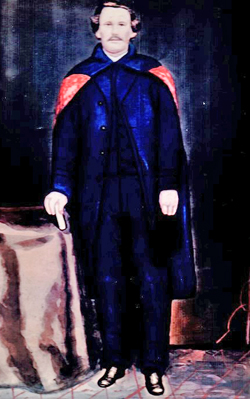Joseph Haberstroh, 1843–1927
|
Joseph Haberstroh was born on 3 March 1843 in Hecklingen, Freiburg, Baden, Germany, as the second child of Andreas “Andrew” Haberstroh and Josepha “Josephine” Hemerle. He had ten siblings: Albertina, Raymond, Amalia, Anton, Andreas, Anna, Henry, Mary, Albert, and William. His family left Germany, departing from Le Havre, France, on 23 April 1850 to New Orleans. After arriving in New Orleans, the family moved north to Johnson County, Iowa. Sometime after the 1850 census, but before the 1860 census, the family moved to St. Louis County near Rock Hill, Missouri, where Andrew rented a farm, and sons Joseph and Richard were farm hands. Joseph enlisted into the Union Army on 1 September 1861, at the St. Louis Arsenal. He served with Captain Welfley’s Battery, Missouri Volunteers, Light Artillery, then transferred to the 2nd Battery B, 1st Regiment, Missouri Light Artillery. Joseph mustered out as a corporal on 30 September 1864. When he was twenty-four, Joseph married Elizabeth Mary Dauernheim, daughter of Phillip Dauernheim and Catherine Elisabeth Wagner, on 23 February 1868 in St. Peters Church, 14th and Carr in St. Louis. Joseph was an entrepreneur. The St. Louis city directory lists him as a stone contractor operating a limestone quarry and he sold road gravel near the older St. Louis School of Pharmacy site. He also operated Haberstroh Grove (Forest Park Garden in 1876), the grounds adjacent to the quarry. I found newspaper ads for the Forest Park Grove, 1870–1875, and Haberstroh Grove, from 1876 to 1888, managed by Joseph Haberstroh. The ads give the location of the Groves on Clayton east of Kingshighway. He later operated saloons at 412 Chestnut and 2219 and 2317 Franklin Avenue. In 1919, he was a teamster for the Southwestern Bell Telephone Company. Joseph Haberstroh donated the large bell for the St. Joseph parish at Eleventh and Biddle Street in 1881. The large bell has a diameter of five and a half feet and weighs 6,000 pounds; it is the largest bell in the state of Missouri. Its tone is a deep “B.” Originally it was rung by ropes, but since 1986 by an electric striker. We don’t know for sure why he donated the bell. |
 Joseph Haberstroh, c. 1860s Photo in the collection of Daniel Davis Used with permission |
|
In 1866, St. Louis had an outbreak of cholera and the parish was having up to twenty burials a day. The members vowed to St. Joseph that if the deaths would stop, they would build a monument to St. Joseph. The deaths stopped the next day. The church was enlarged in 1880–81 and the twin towers added to the façade. Joseph Haberstroh had lost his grandfather Anton, his uncle Casimir, and his nephew Christopher (age ten) to cholera in Iowa in 1850. So, it could be the cholera connection. Joseph was Catholic in Germany but married into the Evangelical Lutheran faith. Joseph died on 25 October 1927, in St. Louis with burial in the Dauernheim family plot in Bethany UCC Cemetery located at 6740 St. Charles Rock Road, Wellston, Missouri. Written by Daniel Davis |
|
© 2021, St. Louis Genealogical Society
Return to St. Louis City/County Biographies.
Last Modified: 14-Mar-2021 18:05